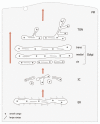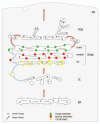A brief history of the cisternal progression-maturation model
- PMID: 21686099
- PMCID: PMC3109463
- DOI: 10.4161/cl.1.1.14693
A brief history of the cisternal progression-maturation model
Figures



Similar articles
-
COPI is essential for Golgi cisternal maturation and dynamics.J Cell Sci. 2016 Sep 1;129(17):3251-61. doi: 10.1242/jcs.193367. Epub 2016 Jul 21. J Cell Sci. 2016. PMID: 27445311 Free PMC article.
-
Stacking the odds for Golgi cisternal maturation.Elife. 2016 Aug 19;5:e16231. doi: 10.7554/eLife.16231. Elife. 2016. PMID: 27542195 Free PMC article.
-
Regulation of Golgi Cisternal Progression by Ypt/Rab GTPases.Dev Cell. 2016 Feb 22;36(4):440-52. doi: 10.1016/j.devcel.2016.01.016. Dev Cell. 2016. PMID: 26906739 Free PMC article.
-
A cisternal maturation mechanism can explain the asymmetry of the Golgi stack.FEBS Lett. 1997 Sep 8;414(2):177-81. doi: 10.1016/s0014-5793(97)00984-8. FEBS Lett. 1997. PMID: 9315681 Review.
-
A Kinetic View of Membrane Traffic Pathways Can Transcend the Classical View of Golgi Compartments.Front Cell Dev Biol. 2019 Aug 6;7:153. doi: 10.3389/fcell.2019.00153. eCollection 2019. Front Cell Dev Biol. 2019. PMID: 31448274 Free PMC article. Review.
Cited by
-
COPI is essential for Golgi cisternal maturation and dynamics.J Cell Sci. 2016 Sep 1;129(17):3251-61. doi: 10.1242/jcs.193367. Epub 2016 Jul 21. J Cell Sci. 2016. PMID: 27445311 Free PMC article.
-
Getting Sugar Coating Right! The Role of the Golgi Trafficking Machinery in Glycosylation.Cells. 2021 Nov 23;10(12):3275. doi: 10.3390/cells10123275. Cells. 2021. PMID: 34943782 Free PMC article. Review.
-
Mechanisms and concepts paving the way towards a complete transport cycle of plant vacuolar sorting receptors.Plant Cell. 2012 May;24(5):1714-32. doi: 10.1105/tpc.112.095679. Epub 2012 May 8. Plant Cell. 2012. PMID: 22570446 Free PMC article. Review.
-
Quantitative intra-Golgi transport and organization data suggest the stable compartment nature of the Golgi.Elife. 2025 Jul 8;13:RP98582. doi: 10.7554/eLife.98582. Elife. 2025. PMID: 40626580 Free PMC article.
-
Stacking the odds for Golgi cisternal maturation.Elife. 2016 Aug 19;5:e16231. doi: 10.7554/eLife.16231. Elife. 2016. PMID: 27542195 Free PMC article.
References
-
- Rink J, Ghigo E, Kalaidzidis Y, Zerial M. Rab conversion as a mechanism of progression from early to late endosomes. Cell. 2005;122:735–749. - PubMed
-
- Poteryaev D, Datta S, Ackema K, Zerial M, Spang A. Identification of the switch in early-to-late endosome transition. Cell. 2010;141:497–508. Comment in: Cell 2010; 141:404–6. - PubMed
-
- Behnia R, Munro S. Organelle identity and the sign-posts for membrane traffic. Nature. 2005;438:597–604. - PubMed
-
- Grassé P-P. Ultrastructure, polarité et reproduction de l'appareil de Golgi. CR Acad Sci (Paris) 1957;245:1278–1281. (Fre). (French) - PubMed
-
- Morré DJ. Membrane differentiation and the control of secretion: a comparison of plant and animal Golgi apparatus. In: Brinkley BR, Porter KR, editors. International Cell Biology. New York: Rockefeller University Press; 1977. pp. 293–303.
LinkOut - more resources
Full Text Sources
